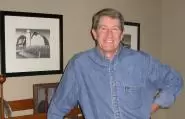The Man Who Opened Up the Arts & Crafts World For Us

In 1972, the year “The Arts & Crafts Movement in America” opened to little fanfare in Princeton, New Jersey, I was an idealistic, naïve, war-protesting English major in Illinois, searching for a job teaching high school students how to write essays.
I not only did not collect Arts & Crafts at that time, but I had actually turned down the opportunity to buy an enormous Roycroft desk (imagine me thinking it was too large) and had left my father’s first desk, a quartersawn oak Stickley Brothers’ dropfront, back in my parents’ attic when I moved into my first house.
But when the light bulb finally did come on, I did have the good sense to buy a copy of Robert Judson Clark’s book, “The Arts & Crafts Movement in America,” and the entire Arts & Crafts world opened up for me. Its sitting here next to me as I write this column, though the pages are falling out and I ruined its value to a book collector by filling the margins with my notes and comments over the years.
In 1992, I invited Robert Judson Clark to speak at the 6th annual Grove Park Inn Arts & Crafts Conference, marking the 20th anniversary of the Princeton exhibition. That Saturday morning we met at the audio-visual stage in the rear of the Heritage Ballroom, at which time he pointed to the video camera perched on a tripod and asked, “What’s that for?”
From the very first Arts & Crafts Conference I had always videotaped each seminar as a means of preserving each speaker’s presentation for future researchers. Those tapes, which now number more than 150, are housed at The Stickley Museum at Craftsman Farms.
And so I quickly explained to Professor Clark the purpose of the video camera. He listened intently, then stated unequivocally, “I don’t want to be recorded.”
If you knew Robert Judson Clark, then you know what my answer was. This was not open to debate. Was the man modest? To a fault. Was he headstrong? Well, what good writer isn’t?
After my introduction, Professor Clark took the podium and I settled in next to my camera operator on the stage at the rear of the room. As Robert started to speak, the camera operator nudged my shoulder. I looked over to see his finger poised over the Record button, waiting for my signal.
I thought long and hard about it, then shook my head. I didn’t know if Robert would be able to tell from the podium that the camera was running — and couldn’t risk upsetting him once he had begun speaking.
Naturally, it was one of the best talks I have ever heard.
I can still remember what it felt like, sitting there, as Robert took us inside the Princeton exhibition, inside his mind as he struggled to convince those around him of the importance of these objects. The soft-spoken professor mesmerized his audience, as we hung on his every word. And there I sat, knowing I had made a mistake, knowing what I could have done with a simple nod of my head.
But, in the years since then, anytime a speaker has expressed any reluctance to being videotaped, I have simply told them this story and they have understood.
So, while we are missing one seminar tape, we have all of the others, in part, because of it.
Before closing, we are wrapping up the catalog for next month’s Arts & Crafts Conference, but are making room in it for a tribute to Robert Judson Clark. If you have a brief recollection or thanks you would like to share, please email it to me in the next few days.

Until next Monday,
With sadness, appreciation and inspiration,
Bruce
